Monacor HSE-70WP Bruksanvisning
Läs gratis den bruksanvisning för Monacor HSE-70WP (2 sidor) i kategorin mikrofon. Guiden har ansetts hjälpsam av 23 personer och har ett genomsnittsbetyg på 5.0 stjärnor baserat på 12 recensioner. Har du en fråga om Monacor HSE-70WP eller vill du ställa frågor till andra användare av produkten? Ställ en fråga
Sida 1/2

ELECTRONICS FOR SPECIALISTS ELECTRONICS FOR SPECIALISTS ELECTRONICS FOR SPECIALISTS ELECTRONICS FOR SPECIALISTS ELECTRONICS FOR SPECIALISTS ELECTRONICS
HSE-70WP
Bestell-Nr. • Order No. 23.6040
MONACOR INTERNATIONAL GmbH & Co. KG • Zum Falsch 36 • 28307 Bremen • Germany
Copyright
©
by MONACOR INTERNATIONAL. All rights reserved.
A-1905.99.01.05.2018
2
3 1
2k2
Kopfbügelmikrofon
Diese Bedienungsanleitung richtet sich an Be-
nutzer ohne besondere Fachkenntnisse. Bitte
lesen Sie die Anleitung vor dem Betrieb gründ-
lich durch und heben Sie sie für ein späteres
Nachlesen auf.
1 Einsatzmöglichkeiten
Dieses spritzwassergeschützte Kopfbügelmikrofon
ist fürden Betrieb mit einem Taschensender eines
draht losen Audio-Übertragungssystems vorgese-
hen (z. B. ein Taschensender TXS-...HSE mit 3-poli-
gem Mini -XLR-Anschluss). Es eignet sich damit op-
timal für Gesangs- und Sprachanwendungen, die
im Freien oder bei hoher Umgebungsfeuchtigkeit
stattfinden und viel Bewegungsfreiheit erfordern,
z. B. bei Outdoor-Aktivitäten.
Alternativ zum Betrieb mit einem Taschensender
lässt sich das Mikrofon auch über einen Speisead-
apter (z. B. EMA-1), der die Mikrofonversorgungs-
spannung bereitstellt, mit einem Audiogerät, z. B.
Mischpult, verbinden.
2 Wichtige Hinweise
Das Mikrofon entspricht allen relevanten Richtlinien
der EU und trägt deshalb das
-Zeichen.
•
Schützen Sie das Mikrofon vor großer Kälte
und Hitze (zulässiger Einsatztemperaturbereich
0 – 40 °C).
•
Das Mikrofon ist spritzwassergeschützt (IP x4),
jedoch nicht völlig wasserdicht. Tauchen Sie es
nicht in Wasser ein.
•
Verwenden Sie zum Reinigen keine aggressiven
Reinigungsmittel oder Chemikalien.
•
Wird das Mikrofon zweckentfremdet, falsch ange-
schlossen oder nicht fachgerecht repariert, kann
keine Haftung für daraus resultierende Sach-
oder Personenschäden und keine Garantie für das
Mikrofon übernommen werden.
Soll das Mikrofon endgültig aus dem
Betrieb genommen werden, übergeben
Sie es zur umweltgerechten Entsorgung
einem örtlichen Recyclingbetrieb.
3 Inbetriebnahme
1) Den Kopfbügel aufsetzen.
2) Der Kopfbügel und der Mikrofonarm lassen sich
wie gewünscht biegen, so dass der Bügel sicher
am Kopf sitzt und das Mikrofon sich in einer güns-
tigen Sprechposition befindet.
3) Das Mikrofon an den Eingang des Taschensenders
anschließen oder über einen Speiseadapter mit
einem Mikrofoneingang des Audiogeräts verbin-
den.
4 Technische Daten
Typ / Richtcharakteristik: Back-Elektret / Niere � � � �
Frequenzbereich: � � � � � � � � � � 100 – 14 000 Hz
Impedanz: � � � � � � � � � � � � � � � 2 kΩ
Empfindlichkeit: � � � � � � � � � � 7,9 mV/ Pa bei 1 kHz
Maximaler Schalldruck: � � � � � 115 dB
Stromversorgung: � � � � � � � � �
⎓
1,5 – 9 V über Taschen-
sender oder Speiseadapter
Gewicht:
� � � � � � � � � � � � � � � � 60 g
Anschluss: � � � � � � � � � � � � � � Mini-XLR, 3-polig
Kontaktbelegung:
� � � � � � � � 1 = Masse
2 = Audiosignal
3 = Stromversorgung
Änderungen vorbehalten.
Headband Microphone
These operating instructions are intended for
users without any specific technical knowledge.
Please read the instructions carefully prior to
operation and keep them for later reference.
1 Applications
This splashproof headband microphone is designed
to be used in combination with a pocket transmit-
ter of a wireless audio transmission system (e. g. a
pocket transmitter TXS-…HSE with 3-pole mini XLR
connection). Itis ideally suited for vocal sound and
speech applications that are performed in the open
or in an environment with high air humidity and
that require much freedom of movement, e. g. for
outdoor activities.
As an alternative to operation with a pocket
transmitter, the microphone may be connected to
an audio unit, e. g. mixer, by means of a power sup-
ply adapter (e. g. EMA-1) that provides the micro-
phone with power.
2 Important Notes
The microphone corresponds to all relevant direc-
tives of the EU and is therefore marked with
.
•
Protect the microphone against very high or low
temperatures (admissible ambient temperature
range 0 – 40 °C).
•
The microphone is splashproof , but not (IP x4)
absolutely watertight. Do not immerse the micro-
phone in water.
•
Do not use aggressive detergents or chemicals for
cleaning.
•
No guarantee claims for the microphone and no
liability for any resulting personal damage or
material damage will be accepted if the micro-
phone is used for other purposes than originally
intended, if it is not correctly connected, or if it is
not repaired in an expert way.
If the microphone is to be put out of oper-
ation definitively, take it to a local recycling
plant for a disposal which is not harmful to
the environment.
3 Setting into Operation
1) Put the headband on your head.
2) Bend the headband and the microphone arm as
required to make sure that the headband fits
securely and the microphone is in an optimum
position.
3) Connect the microphone to the input of the
pocket transmitter or connect it to a microphone
input of the audio unit, using a power supply
adapter.
4 Specifications
Type / pick-up characteristic: � back electret /cardioid
Frequency range: � � � � � � � � � 100 – 14 000 Hzz
Impedance: � � � � � � � � � � � � � � 2 kΩ
Sensitivity: � � � � � � � � � � � � � � 7�9 mV/ Pa at 1 kHz
Maximum SPL: � � � � � � � � � � � 115 dB
Power supply: � � � � � � � � � � � �
⎓
1�5 – 9 V via pocket
transmitter or power supply
adapter
Weight:
� � � � � � � � � � � � � � � � � 60 g
Connection: � � � � � � � � � � � � � mini XLR, 3 poles
Pin configuration:
� � � � � � � � 1 = ground
2 = audio signal
3 = power supply
Subject to technical modification.
Deutsch
English
Français
Microphone serre-tête
Cette notice s‘adresse aux utilisateurs sans
connaissances techniques particulières. Veuil-
lez lire la présente notice avec attention avant
le fonctionnement et conservez-la pour pou-
voir vous y reporter ultérieurement.
1 Possibilités d’utilisation
Ce microphone serre-tête protégé contre les écla-
boussures est conçu pour un fonctionne ment avec
un émetteur de poche d’un système de transmis-
sion audio sans fil (p. ex. un émetteur de poche
TXS-…HSE avec mini XLR 3 pôles). Il est ainsi adapté
de manière optimale pour des applications de chant
et de discours en extérieur ou dans un environne-
ment humide et nécessitant une grande liberté de
mouvements, p. ex. pour des activités de plein air.
A la place du fonctionnement avec un émetteur
de poche, le microphone peut être relié à un appa-
reil audio, p. ex. table de mixage, via un adaptateur
d’alimentation (p. ex. EMA-1) qui met à disposition
l’alimentation pour le microphone.
2 Conseils importants
Le microphone répond à toutes les directives né-
cessaires de l’Union européenne et porte donc le
symbole .
•
Protégez le microphone de températures très éle-
vées ou très basses (température ambiante admis-
sible 0 – 40 °C).
•
Le microphone est protégé contre les éclabous-
sures (IP x4) mais il n’est pas totalement étanche.
Ne le plongez pas dans l’eau.
•
Pour le nettoyage n’utilisez pas de produits dé-
tergents abrasifs ou de produits chimiques.
•
Nous déclinons toute responsabilité en cas de
dommages corporels ou matériels résultants si le
microphone est utilisé dans un but autre que celui
pour lequel il a été conçu, s’il n’est pas correcte-
ment branché ou s’il n’est pas réparé par une per-
sonne habilitée ; en outre, tout droit à la garantie
deviendrait caduque.
Lorsque le microphone est définitivement
retiré du service, vous devez le déposer
dans une usine de recyclage adaptée pour
contribuer à son élimination non polluante.
3 Fonctionnement
1) Placez le serre-tête.
2) Vous pouvez plier le serre-tête et le bras de micro
à votre convenance pour que le serre-tête soit
bien positionné sur la tête et que le microphone
se trouve dans une position optimale.
3) Reliez le microphone à l’entrée de l’émetteur de
poche ou, via un adaptateur d’alimentation, à
une entrée microphone de l’appareil audio.
4 Caractéristiques techniques
Type /caractéristique : � � � � � � back-électret /cardioïde
Bande passante : � � � � � � � � � 100 – 14 000 Hzz
Impédance : � � � � � � � � � � � � � 2 kΩ
Sensibilité : � � � � � � � � � � � � � � 7,9 mV/ Pa à 1 kHz
Pression sonore maximale : � � 115 dB
Alimentation : � � � � � � � � � � � �
⎓
1,5 – 9 V via émetteur de
poche ou adaptateur alimen-
tation
Poids :
� � � � � � � � � � � � � � � � � � 60 g
Branchement : � � � � � � � � � � � mini XLR, 3 pôles
Configuration des contacts : 1 = masse, 2 = signal audio,
3 = alimentation
Tout droit de modification réservé.
CARTONS ET EMBALLAGE
PAPIER À TRIER
Produktspecifikationer
| Varumärke: | Monacor |
| Kategori: | mikrofon |
| Modell: | HSE-70WP |
Behöver du hjälp?
Om du behöver hjälp med Monacor HSE-70WP ställ en fråga nedan och andra användare kommer att svara dig
mikrofon Monacor Manualer
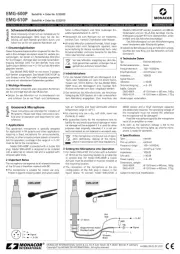
29 Augusti 2025
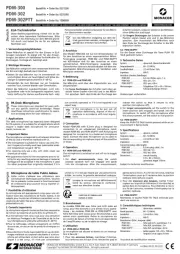
29 Augusti 2025
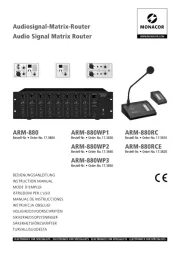
29 Augusti 2025
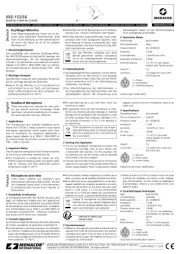
29 Augusti 2025
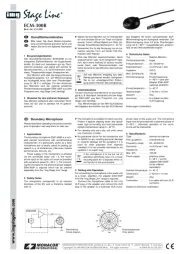
28 Augusti 2025
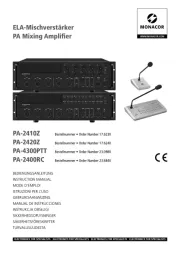
28 Augusti 2025

8 Januari 2025

5 September 2024

4 September 2024

4 September 2024
mikrofon Manualer
- VTech
- Roland
- Mars Gaming
- Earthworks
- Sony
- Oktava
- STRICH
- Plantronics
- DOCKIN
- Livoo
- Fluid
- Audix
- Nuance
- Switchcraft
- Power Dynamics
Nyaste mikrofon Manualer
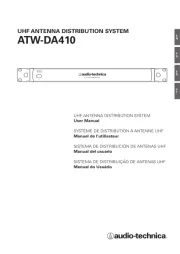
19 Oktober 2025
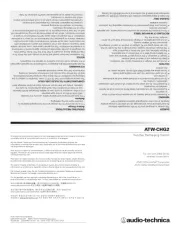
19 Oktober 2025

18 Oktober 2025
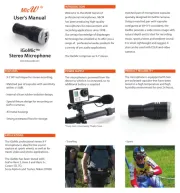
18 Oktober 2025
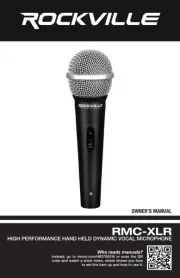
18 Oktober 2025

18 Oktober 2025
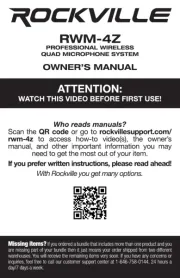
18 Oktober 2025
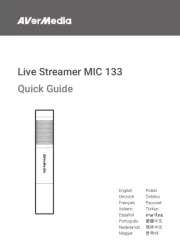
16 Oktober 2025
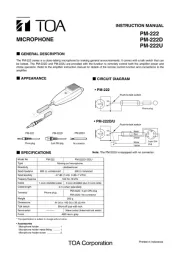
15 Oktober 2025
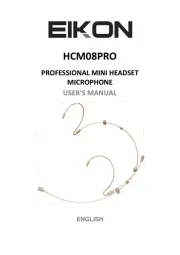
13 Oktober 2025